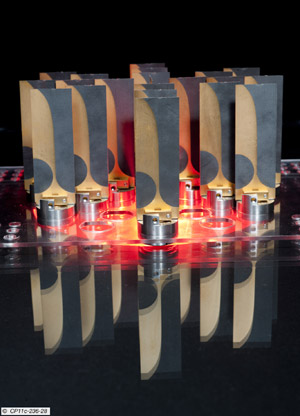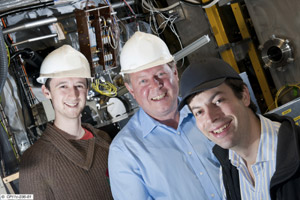York’s new microwave imaging system worth its weight in gold
Working towards a carbon-free energy future

Scientists predict that nuclear fusion – the process that powers the Sun – will play a large part in our carbon-free energy future, creating clean energy in tomorrow’s power stations.
Researchers from the University of York’s Department of Physics are working on the UK Fusion Programme experiment MAST (Mega Amp Spherical Tokamak), located at Culham Centre for Fusion Energy (CCFE),to make this goal a reality.
To obtain energy from fusion, gas from a combination of types of hydrogen – deuterium and tritium – is heated to very high temperatures – 100 million degrees Celsius. One way to achieve these conditions is by a method called ‘magnetic confinement' – controlling the hot gas (known as a plasma) with strong magnets.
A key element of MAST’s mission is the design, development and deployment of novel diagnostics to gain a better understanding of what is happening inside the plasma.
Dr Roddy Vann from the York Plasma Institute in the University of York’s Department of Physics, Dr Vladimir Shevchenko from CCFE and their PhD student Simon Freethy have designed, installed and are now gathering data from an innovative microwave camera – the MAST Electron Bernstein Wave (EBW) emission imaging system. This system measures the position, intensity and shape of microwave emissions from the edge of the plasma.
The detector itself consists of 37 antennas made of printed circuit board material covered with gold, of which up to eight at any time are used to detect microwaves from the plasma at frequencies similar to those in a typical microwave oven. These measurements allow the calculation of how much electrical current is flowing near the edge of the plasma. Moreover, the system has an active probing capability which enables mapping of structures on the plasma surface rather like RADAR.
Dr Vann says, “Measuring currents on the plasma edge is important because they are thought to determine the dynamics of sudden eruptive instabilities – Edge Localised Modes (ELMs) – during which substantial quantities of stored plasma energy are lost.
 “Knowledge of these instabilities is vital for the development of a commercial power plant in which ELMs must be controlled or their effects mitigated. While ELMs are tolerated in present day devices, they constitute a potentially serious heat-load problem for the ITER tokamak and future fusion energy facilities. There are a lot of key physics questions to answer about ELMs and we are looking forward to using our new imaging system to probe them.”
“Knowledge of these instabilities is vital for the development of a commercial power plant in which ELMs must be controlled or their effects mitigated. While ELMs are tolerated in present day devices, they constitute a potentially serious heat-load problem for the ITER tokamak and future fusion energy facilities. There are a lot of key physics questions to answer about ELMs and we are looking forward to using our new imaging system to probe them.”
Dr Brian Lloyd, CCFE’s MAST Experiments Department Manager, says, “Exciting new developments such as this keep MAST at the forefront of fusion research and demonstrate the value of close collaboration with our international and UK university partners.”
Research carried out by the York Plasma Institute is playing an influential role in the international science programme for ITER. In excess of €10bn, ITER is an experimental fusion device under construction in southern France. The multinational facility will answer the final questions on fusion energy before the construction of a demonstration fusion power plant. If the scientific and technological challenges can be overcome, fusion offers the potential for an effectively limitless supply of safe, environmentally friendly energy.
Further information
- Work at the Culham Centre for Fusion Energy (CCFE) in Oxfordshire is funded by the Engineering and Physical Sciences Research Council (EPSRC) and the European Union. The EBW imaging project was funded by an ESPRC First Grant, and contributions from CCFE and the University of York’s Strategic Equipment Fund.
- The York Plasma Institute is an innovative £6 million partnership between the Engineering and Physical Sciences Research Council (EPSRC) and the University of York which is creating a world-leading inter-disciplinary plasma research centre. More information at www.york.ac.uk/physics/ypi
- More information on the Culham Centre for Fusion Energy (CCFE) at www.ccfe.ac.uk
